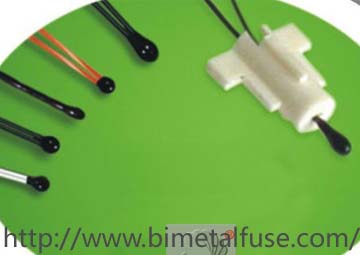What is a thermistor?
Thermistor is a kind of sensitive components, Also known as semiconductor resistors. It can be made of single crystal, Polycrystalline and glass, Plastic and other semiconductor materials. This resistor has a series of special electrical properties, The most basic characteristic is its resistance with the temperature changes have a very significant change, And the voltammetric curve is nonlinear.
Thermistor Category:
Thermistor a wide range, According to the temperature coefficient is divided into positive temperature coefficient thermistor (PTC) and negative temperature coefficient thermistor (NTC). Thermistor is a typical feature of temperature-sensitive, Different temperatures show different resistance values. Positive temperature coefficient thermistor (PTC) in the higher the temperature the greater the resistance value. Negative temperature coefficient thermistor (NTC) in the higher the temperature the lower the resistance value, They belong to the same semiconductor device.
According to its resistance with the size of the temperature changes can be divided into slow and mutant;
According to their heat can be divided into direct thermal and side heat;
According to their operating temperature range can be divided into room temperature, High temperature and ultra-low temperature thermistor;
According to its structure classification rod, wafer, square piece, washer-like, spherical, line tubular, thin film and thick film.
Thermistor basic features:
The main features of thermistor is the high temperature sensitivity,Thermal inertia small, long life, small size, simple structure, And can be made into a variety of different shape structure.
Thermistor uses a wide range. The main applications are:
1> The resistance-temperature characteristic is used to measure the temperature, Control temperature and components, devices, circuit temperature compensation;
2> the use of non-linear characteristics to complete voltage regulation, limiting, switching, overcurrent protection;
3> use of different media in the heat dissipation characteristics of the difference between measurement of flow, Flow rate, liquid level, thermal conductivity, vacuum, etc .;
4> Use thermal inertia as a time delay
5> High sensitivity, The temperature coefficient of resistance than the metal 10 to 100 times more, Can detect the temperature change of 10-6 ℃;
6> Wide operating temperature range, Room temperature device for -55 ℃ ~ 315 ℃. High temperature device for the temperature above 315 ℃ (currently up to 2000 ℃). Low temperature device for -273 ℃ ~ -55 ℃;
7> Small size, can measure other thermometers can not measure the gap,The temperature of the blood vessel in the cavity and the organism;
Thermistor Application:
Therefore, with the industrial and agricultural production and the development of science and technology, This kind of component has already obtained the extensive application, Such as temperature measurement, temperature control, temperature compensation, liquid level measurement, Pressure measurement, fire alarm, weather sounding, switching circuits, Overload protection, pulse voltage suppression, time delay, stable amplitude, Automatic gain adjustment, microwave and laser power measurement and so on.

Thermistor Category:
Thermistor a wide range, According to the temperature coefficient is divided into positive temperature coefficient thermistor (PTC) and negative temperature coefficient thermistor (NTC). Thermistor is a typical feature of temperature-sensitive, Different temperatures show different resistance values. Positive temperature coefficient thermistor (PTC) in the higher the temperature the greater the resistance value. Negative temperature coefficient thermistor (NTC) in the higher the temperature the lower the resistance value, They belong to the same semiconductor device.
According to its resistance with the size of the temperature changes can be divided into slow and mutant;
According to their heat can be divided into direct thermal and side heat;
According to their operating temperature range can be divided into room temperature, High temperature and ultra-low temperature thermistor;
According to its structure classification rod, wafer, square piece, washer-like, spherical, line tubular, thin film and thick film.
Thermistor basic features:
The main features of thermistor is the high temperature sensitivity,Thermal inertia small, long life, small size, simple structure, And can be made into a variety of different shape structure.
Thermistor uses a wide range. The main applications are:
1> The resistance-temperature characteristic is used to measure the temperature, Control temperature and components, devices, circuit temperature compensation;
2> the use of non-linear characteristics to complete voltage regulation, limiting, switching, overcurrent protection;
3> use of different media in the heat dissipation characteristics of the difference between measurement of flow, Flow rate, liquid level, thermal conductivity, vacuum, etc .;
4> Use thermal inertia as a time delay
5> High sensitivity, The temperature coefficient of resistance than the metal 10 to 100 times more, Can detect the temperature change of 10-6 ℃;
6> Wide operating temperature range, Room temperature device for -55 ℃ ~ 315 ℃. High temperature device for the temperature above 315 ℃ (currently up to 2000 ℃). Low temperature device for -273 ℃ ~ -55 ℃;
7> Small size, can measure other thermometers can not measure the gap,The temperature of the blood vessel in the cavity and the organism;
Thermistor Application:
Therefore, with the industrial and agricultural production and the development of science and technology, This kind of component has already obtained the extensive application, Such as temperature measurement, temperature control, temperature compensation, liquid level measurement, Pressure measurement, fire alarm, weather sounding, switching circuits, Overload protection, pulse voltage suppression, time delay, stable amplitude, Automatic gain adjustment, microwave and laser power measurement and so on.






